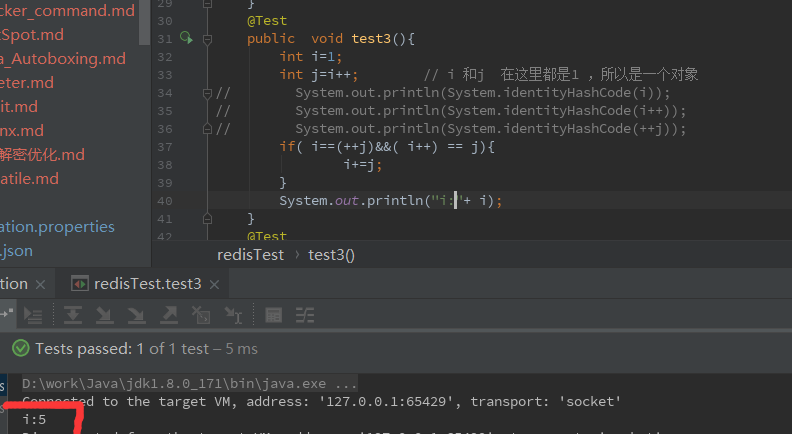I. Sample Code
@Test public void test3(){ int i=1; int j=i++; if( i==(++j)&&( i++) == j){ i+=j; } System.out.println("i'"+ i); }
- The results are as follows:5

- So why does that happen? Look closely
2. Auto-loading and disassembling
-
Definition
- Auto-packing, after compiling, is transformed into the corresponding packaging method, Integer.valueOf ();
Integer i =1; executed in compilation: Integer i= Integer.valueOf(int i);
- After compilation, it is converted to the corresponding restore method, Integer.intValue () method.
int j = i++; perform unboxing in compilation, int j = Integer.inValue(i);
- The example calls unboxing. The constant pool in the java virtual machine includes Integer constant pool, which is stored in a table. The details are as follows:

The stored range value defaults to - 128 - 127, so if Interger points to the number in this range, it will directly point to the object in the constant pool at compilation time.
3. Comparing addresses in two ways:
-
First kind
System.out.println(System.identityHashCode(i)); System.out.println(System.identityHashCode(i++)); System.out.println(System.identityHashCode(++j)); -
Second kinds
public class javaAuto { static final Unsafe unsafe = getUnsafe(); static final boolean is64bit = true; public static void main(String... args) { int i=1; int j=i++; System.out.println("-------------------------"); System.out.println("----"); printAddresses("i", i); System.gc(); System.out.println("----"); printAddresses("j", ++j); System.gc(); System.out.println("----"); printAddresses("i++", i++); } public static void printAddresses(String label, Object... objects) { System.out.print(label + ": 0x"); long last = 0; int offset = unsafe.arrayBaseOffset(objects.getClass()); int scale = unsafe.arrayIndexScale(objects.getClass()); switch (scale) { case 4: long factor = is64bit ? 8 : 1; final long i1 = (unsafe.getInt(objects, offset) & 0xFFFFFFFFL) * factor; System.out.print(Long.toHexString(i1)); last = i1; for (int i = 1; i < objects.length; i++) { final long i2 = (unsafe.getInt(objects, offset + i * 4) & 0xFFFFFFFFL) * factor; if (i2 > last) System.out.print(", +" + Long.toHexString(i2 - last)); else System.out.print(", -" + Long.toHexString( last - i2)); last = i2; } break; case 8: throw new AssertionError("Not supported"); } System.out.println(); } private static Unsafe getUnsafe() { try { Field theUnsafe = Unsafe.class.getDeclaredField("theUnsafe"); theUnsafe.setAccessible(true); return (Unsafe) theUnsafe.get(null); } catch (Exception e) { throw new AssertionError(e); } } } - The addresses of i, i++, ++ J printed in both ways are the same; what are their values?
Four, value
- The values of i and + + j are both 2, which is beyond doubt.
- (i++)==j, this comparison, the landlord suspects is the first to perform the comparison, and then to perform the + + operation, but it does not seem to conform to the operation rules of operators.
- To be checked... I would appreciate it if someone could tell me the answer.
Reference link: https://blog.csdn.net/isscollege/article/details/78398968
Welcome to the Public Number for more information: 